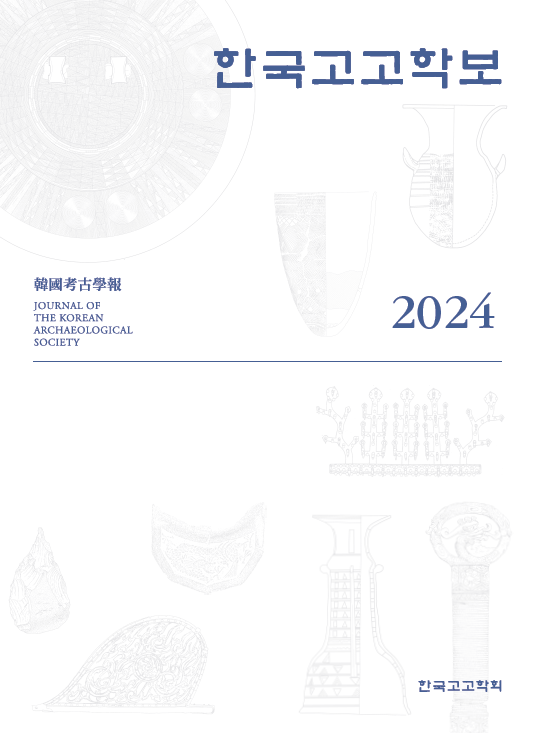이 논문에서는 마립간기 6부의 내부 조직을 진단해 본다는 목적 아래, 월성북고분군을 주된 대상으로 금척리고분군, 전후 시기의 중심 고분군 등을 비교 분석하고 문헌의 연구 성과와도 상호 피드백하여 종합적인 해석을 끌어내고자 하였다. 4~6세기 경주 고총군에서 중점적으로 분석할 대상을 1그룹: 70m급 이상, 2그룹: 50~55m급, 3그룹: 35~45m급으로 설정하였으며, 이 봉토분들은 지방에서 파악되는 최대 규모 등급을 상회하는 차별화된 무덤들이었다. 월성북고분군에서 고총 군집의 묘역별 형성 과정을 보면, 기존의 북쪽 목곽묘 묘역에서 연속되어 고총들이 자리 잡는 A-1군의 양상과 본래 별다른 묘역이 없던 바깥쪽 습지 경계에 새로이 고총 군집이 들어서는 B군, C군의 양상으로 구분된다. A-1군, B군, C군은 각기 탁, 피, 한기라는 초기 부에 대응된다고 본다. 4세기 중~후엽경, 6부로 분화되기 전에 최초 3부의 양상으로 월성북고분군에 선제적으로 결집되었던 것이다. 연이어 1그룹, 2그룹의 초대형분들과 3그룹 대형분들 위주로 결집되는 A-2군(황남대총 중심)이 분리되는데, 왕경 중심부에서 마립간을 포함한 간급 지위를 보유한 유력자들이 그들만의 공동체의 묘역을 구축했다고 보았다. 5세기로 넘어가면 내물마립간 가계와 실성마립간 일파의 세력 다툼 속에서 탁, 사탁, 모탁, 본피, 습비, 한기라는 6부 분화가 일단락된다. 고총 현상에서는 사탁부의 장이었던 갈문왕 무덤(마립간릉 3기를 제외한 2그룹 고총)이 A-2군에서 지속적으로 조영되며, 모탁부의 묘역인 금척리고분군만은 본래 근거지에서 구축되긴 하나 탁, 사탁의 간급 묘역이 추구했던 배치 원리를 그대로 따랐다고 추론된다. 눌지마립간 재위(417~458년) 동안 축출된 실성마립간 일파를 A-3군 묘역(119호분 일대)으로 따로 떼어 놓는 동시에, 왕위 계승에서 부자 상속이 확립되는 토대를 갖추게 된다. 또 이때부터 탁부와 사탁부가 중심이 된 국정 운영이 본격화되면서 나머지 4부의 세력 약화가 초래되었고, 월성북고분군에 구축된 여타 부들의 고총 묘역은 대세적으로 위축될 수밖에 없었다. 눌지-자비-소지에 이르는 3대 마립간에 걸쳐, A-4군(봉황대 일군)은 마립간 일족의 묘역으로 분화되었으며, 중고기 왕릉들만 구성된 서악동고분군으로 넘어가기 전의 과도기라 할 수 있다.
This paper aims to trace the 6 bu organization of the Maripgan Period. For this purpose, a comprehensive interpretation was derived by comparing and analyzing the the Wol-seong North Ancient Tombs with the Geumcheok-ri Ancient Tombs and the central tombs constructed in the time period before and after the Wolseong North Ancient Tombs. The formation process of Wolseong North Ancient Tombs cluster consisted of the es-tablishment of the A-1 group, in which the high mounded tombs were built continuously nearby the pre-existing wooden chamber burials to the north, and the establishment of the B and C groups, in which new high mounded tombs were built along the outer wetland boundary, where there was no pre-existing burial ground. Groups A-1, B, and C are con-sidered to correspond to the three initial bu (Tak (喙), Pi (彼), Hangi (漢岐)). Before the divi-sion into 6 bu around the middle to late 4th century, the initial 3 bu were gathered togeth-er in the area of the Wolseong North Ancient Tombs. Subsequently, the A-2 group (centered around Hwangnamdaechong Tomb), which mainly consists of the super-large tombs of Group 1 and Group 2 and the large tombs of Group 3, came to be separated. The reason for this is likely the establishment of a separate burial ground for Gan (干支) status individuals in the center of the capital city. Moving forward to the 5th century, the 6 bu divisions of Tak (喙), Satak (沙喙), Motak (岑喙), Bonpi (本彼), Seupbi (斯彼), and Hangi (漢岐) were completed amid the power struggle between the Maripgan groups. The tomb of King Galmun, the head of Satak-bu, was continuously built in the A-2 burial ground. It is inferred that although the tombs of Motak-bu (the Geumcheok-ri Anceint Tombs) continued to be built at the group’s original burial ground, it followed the arrangement principle pursued by the tombs of Tak-bu and Satak-bu. During the reign of Nulji Maripgan (417-458), the ousted Silseong Maripgan faction separated to form A-3 burial ground (in the area of Tomb No. 119), and at the same time, the foundations for the principle of father to son succession for the Silla throne were estab-lished. Throughout the reign of the three major Maripgans ranging from Nulji to Jabi-Soji, A-4-burial ground (in the area of Bonghwangdae) was seperated to form the burial grounds of the Maripgan clan.
Ⅰ. 머리말
Ⅱ. 연구사, 비교 자료의 검토
Ⅲ. 월성북고분군의 변천과 문헌 기록
Ⅳ. 마립간기 6부의 내부 조직
Ⅴ. 맺음말
